Deck 15: The Origin of the Solar System
سؤال
سؤال
سؤال
سؤال
سؤال
سؤال
سؤال
سؤال
سؤال
سؤال
سؤال
سؤال
سؤال
سؤال
سؤال
سؤال
سؤال
سؤال
سؤال
سؤال
سؤال
سؤال
سؤال
سؤال
سؤال
سؤال
سؤال
سؤال
سؤال
سؤال
سؤال
سؤال
سؤال
سؤال
سؤال
سؤال
سؤال
سؤال
سؤال
سؤال
سؤال
سؤال
سؤال
سؤال
سؤال
سؤال
سؤال
سؤال
سؤال
سؤال
سؤال
سؤال
سؤال
سؤال
سؤال
سؤال
سؤال
سؤال
سؤال
سؤال
سؤال
سؤال
سؤال
سؤال
سؤال
سؤال
سؤال
سؤال
سؤال
سؤال
سؤال
سؤال
سؤال
سؤال
سؤال
سؤال
سؤال
سؤال
سؤال
سؤال

فتح الحزمة
قم بالتسجيل لفتح البطاقات في هذه المجموعة!
Unlock Deck
Unlock Deck
1/108
العب
ملء الشاشة (f)
Deck 15: The Origin of the Solar System
1
The hydrogen and helium in our solar system were created from subatomic particles about ____________ years ago.
A)14 billion
B)10.5 billion
C)7.0 billion
D)4.5 billion
A)14 billion
B)10.5 billion
C)7.0 billion
D)4.5 billion
14 billion
2
Outgassing is
A)the adding of material to an object an atom or molecule at a time.
B)the adding of material to an object by collection of solid particles.
C)the release of gas from rocks as they are heated.
D)the largest of the Galilean satellites.
E)caused by the bombardment of the solar wind.
A)the adding of material to an object an atom or molecule at a time.
B)the adding of material to an object by collection of solid particles.
C)the release of gas from rocks as they are heated.
D)the largest of the Galilean satellites.
E)caused by the bombardment of the solar wind.
the release of gas from rocks as they are heated.
3
Which one of the following IS a characteristic of Jovian planets
A)low average density
B)orbits inside the asteroids
C)craters in old surfaces
D)small diameters
E)very few satellites
A)low average density
B)orbits inside the asteroids
C)craters in old surfaces
D)small diameters
E)very few satellites
low average density
4
____________ is the separation of material in a newly formed planet or asteroid according to density. This happens when the object becomes molten.
A)Accretion
B)Differentiation
C)Condensation
D)Outgassing
E)Sublimation
A)Accretion
B)Differentiation
C)Condensation
D)Outgassing
E)Sublimation

فتح الحزمة
افتح القفل للوصول البطاقات البالغ عددها 108 في هذه المجموعة.
فتح الحزمة
k this deck
5
____________ pushed gas and dust particles out of the solar nebula by the light from the Sun.
A)Radiation pressure
B)Outgassing
C)Condensation
D)Accretion
E)Differentiation
A)Radiation pressure
B)Outgassing
C)Condensation
D)Accretion
E)Differentiation

فتح الحزمة
افتح القفل للوصول البطاقات البالغ عددها 108 في هذه المجموعة.
فتح الحزمة
k this deck
6
A future news release might report that a new planet has been found around a star very similar to our Sun. The system contains other planets as well like our solar system. This newly discovered planet is claimed to have a mass 40 times that of Earth and is located nearly 25 AU from the star it orbits. Which of the following would be a reasonable prediction about this planet, assuming it formed like our solar system I.The planet will probably have a mean density of around 5 g/cm3.II.The planet will probably have a radius of around five to ten times greater than Earth's.III.The planet will probably have several satellites.IV.The planet will probably have a composition that is mostly hydrogen and helium.
A)I & IV
B)I, II, & III
C)II, III, & IV
D)I, II, & IV
E)I, II, III, & IV
A)I & IV
B)I, II, & III
C)II, III, & IV
D)I, II, & IV
E)I, II, III, & IV

فتح الحزمة
افتح القفل للوصول البطاقات البالغ عددها 108 في هذه المجموعة.
فتح الحزمة
k this deck
7
Protoplanets
A)grew in size primarily by accretion.
B)grew in size primarily by condensation.
C)are still visible today as the terrestrial planets.
D)grew in size by collecting the particles in the solar wind.
E)grew in size by the collision and coalescing of planetesimals.
A)grew in size primarily by accretion.
B)grew in size primarily by condensation.
C)are still visible today as the terrestrial planets.
D)grew in size by collecting the particles in the solar wind.
E)grew in size by the collision and coalescing of planetesimals.

فتح الحزمة
افتح القفل للوصول البطاقات البالغ عددها 108 في هذه المجموعة.
فتح الحزمة
k this deck
8
The iron in our solar system was created from smaller-mass atomic nuclei in
A)the Earth.
B)our Sun.
C)Jupiter.
D)the big bang.
E)supernovae.
A)the Earth.
B)our Sun.
C)Jupiter.
D)the big bang.
E)supernovae.

فتح الحزمة
افتح القفل للوصول البطاقات البالغ عددها 108 في هذه المجموعة.
فتح الحزمة
k this deck
9
Accretion is
A)the adding of material to an object an atom or molecule at a time.
B)the adding of material to an object by collection of solid particles.
C)the release of gas from rocks as they are heated.
D)the largest of the Galilean satellites.
E)caused by the bombardment of the solar wind.
A)the adding of material to an object an atom or molecule at a time.
B)the adding of material to an object by collection of solid particles.
C)the release of gas from rocks as they are heated.
D)the largest of the Galilean satellites.
E)caused by the bombardment of the solar wind.

فتح الحزمة
افتح القفل للوصول البطاقات البالغ عددها 108 في هذه المجموعة.
فتح الحزمة
k this deck
10
The age of the solar system is believed to be approximately 4.6 billion years based on the data from
A)samples of lunar rocks.
B)samples of Earth rocks.
C)samples of meteorites.
D)samples of lunar rocks, Earth rocks, and meteorites.
E)None of the other choices are correct.
A)samples of lunar rocks.
B)samples of Earth rocks.
C)samples of meteorites.
D)samples of lunar rocks, Earth rocks, and meteorites.
E)None of the other choices are correct.

فتح الحزمة
افتح القفل للوصول البطاقات البالغ عددها 108 في هذه المجموعة.
فتح الحزمة
k this deck
11
____________ are located beyond the asteroid belt (3 AU) from the Sun, have extremely large masses and very low densities.
A)Comets
B)Extrasolar planets
C)Asteroids
D)Terrestrial planets
E)Jovian planets
A)Comets
B)Extrasolar planets
C)Asteroids
D)Terrestrial planets
E)Jovian planets

فتح الحزمة
افتح القفل للوصول البطاقات البالغ عددها 108 في هذه المجموعة.
فتح الحزمة
k this deck
12
A(n) ____________ is a solar-system object that enters Earth's atmosphere and becomes very hot due to friction between the object and Earth's atmosphere and does not survive to reach the surface.
A)asteroid
B)meteor
C)comet
D)meteoroid
E)planetesimal
A)asteroid
B)meteor
C)comet
D)meteoroid
E)planetesimal

فتح الحزمة
افتح القفل للوصول البطاقات البالغ عددها 108 في هذه المجموعة.
فتح الحزمة
k this deck
13
The first small solid grains or flakes formed in our solar system by the process of ____________, the addition of material to an object an atom or molecule at a time.
A)accretion
B)sublimation
C)hydration
D)condensation
E)vaporization
A)accretion
B)sublimation
C)hydration
D)condensation
E)vaporization

فتح الحزمة
افتح القفل للوصول البطاقات البالغ عددها 108 في هذه المجموعة.
فتح الحزمة
k this deck
14
The Jovian problem refers to
A)the high speed with which the Jovian planets rotate on their axes.
B)the large number of satellites that orbit each Jovian planet.
C)the existence of rings around the Jovian planets.
D)the excess heat radiated by the larger of the Jovian planets.
E)the apparently short period of time that disks exist around stars from which Jovian planets can form.
A)the high speed with which the Jovian planets rotate on their axes.
B)the large number of satellites that orbit each Jovian planet.
C)the existence of rings around the Jovian planets.
D)the excess heat radiated by the larger of the Jovian planets.
E)the apparently short period of time that disks exist around stars from which Jovian planets can form.

فتح الحزمة
افتح القفل للوصول البطاقات البالغ عددها 108 في هذه المجموعة.
فتح الحزمة
k this deck
15
An extrasolar planet is
A)a planet that orbits our Sun that we have not yet discovered.
B)one not needed for the formation of our solar system which is kept in a special area just in case.
C)a planet found orbiting around a star other than the Sun.
D)another name for an asteroid.
E)a planet extra close to our Sun.
A)a planet that orbits our Sun that we have not yet discovered.
B)one not needed for the formation of our solar system which is kept in a special area just in case.
C)a planet found orbiting around a star other than the Sun.
D)another name for an asteroid.
E)a planet extra close to our Sun.

فتح الحزمة
افتح القفل للوصول البطاقات البالغ عددها 108 في هذه المجموعة.
فتح الحزمة
k this deck
16
After the first solid grains formed in our solar system, these particles could then grow by the process of ____________, the collision and sticking of one particle with another to continue the formation of planetesimals. Each of these has many atoms or molecules.
A)accretion
B)sublimation
C)hydration
D)condensation
E)vaporization
A)accretion
B)sublimation
C)hydration
D)condensation
E)vaporization

فتح الحزمة
افتح القفل للوصول البطاقات البالغ عددها 108 في هذه المجموعة.
فتح الحزمة
k this deck
17
Once a terrestrial planet had formed from a large number of planetesimals, heat could have melted it and allowed it to differentiate into a metallic core of ____________density and a rocky mantle or crust of ____________ density.
A)higher; lower
B)lower; higher
C)Wrong! The interior stays solid.
D)Wrong! There is no separation according to density.
A)higher; lower
B)lower; higher
C)Wrong! The interior stays solid.
D)Wrong! There is no separation according to density.

فتح الحزمة
افتح القفل للوصول البطاقات البالغ عددها 108 في هذه المجموعة.
فتح الحزمة
k this deck
18
A newly formed planet or large asteroid becomes molten due to
A)the last infalling objects.
B)decay of radioactive element isotopes.
C)the last infalling objects and decay of radioactive element isotopes.
D)none of the other choices as newly formed planets remain solid inside.
A)the last infalling objects.
B)decay of radioactive element isotopes.
C)the last infalling objects and decay of radioactive element isotopes.
D)none of the other choices as newly formed planets remain solid inside.

فتح الحزمة
افتح القفل للوصول البطاقات البالغ عددها 108 في هذه المجموعة.
فتح الحزمة
k this deck
19
Which one of the following IS NOT a characteristic of terrestrial planets
A)low average density
B)orbits inside the asteroids
C)craters in old surfaces
D)small diameters
E)very few satellites
A)low average density
B)orbits inside the asteroids
C)craters in old surfaces
D)small diameters
E)very few satellites

فتح الحزمة
افتح القفل للوصول البطاقات البالغ عددها 108 في هذه المجموعة.
فتح الحزمة
k this deck
20
The hydrogen in our solar system was created from subatomic particles in
A)the Earth.
B)our Sun.
C)Jupiter.
D)the big bang.
E)supernovae.
A)the Earth.
B)our Sun.
C)Jupiter.
D)the big bang.
E)supernovae.

فتح الحزمة
افتح القفل للوصول البطاقات البالغ عددها 108 في هذه المجموعة.
فتح الحزمة
k this deck
21
What observation made of other stars seems to suggest the solar nebula theory is correct
A)Stars are found to exist more often in binaries than by themselves.
B)Protostars are seen to radiate much of their light at infrared wavelengths.
C)Nearby stars tend to be low-mass red dwarfs.
D)Young stars are found to have hot disks that surround them.
A)Stars are found to exist more often in binaries than by themselves.
B)Protostars are seen to radiate much of their light at infrared wavelengths.
C)Nearby stars tend to be low-mass red dwarfs.
D)Young stars are found to have hot disks that surround them.

فتح الحزمة
افتح القفل للوصول البطاقات البالغ عددها 108 في هذه المجموعة.
فتح الحزمة
k this deck
22
On a photograph of the Moon, the Moon measures 30 cm in diameter and a small crater measures 0.2 cm. The Moon's physical diameter is 1738 km. What is the physical diameter of the small crater
A)about 1738 km
B)about 12 km
C)about 520 km
D)about 350 km
E)about 3.5 km
A)about 1738 km
B)about 12 km
C)about 520 km
D)about 350 km
E)about 3.5 km

فتح الحزمة
افتح القفل للوصول البطاقات البالغ عددها 108 في هذه المجموعة.
فتح الحزمة
k this deck
23
51 Pegasi is important because
A)it is a pulsar with planets orbiting around it.
B)it is a star with a planet that is known to support intelligent life.
C)it is the largest satellite of Jupiter.
D)it is the largest known asteroid.
E)it is the first star like our Sun that was found to have a planet orbiting it.
A)it is a pulsar with planets orbiting around it.
B)it is a star with a planet that is known to support intelligent life.
C)it is the largest satellite of Jupiter.
D)it is the largest known asteroid.
E)it is the first star like our Sun that was found to have a planet orbiting it.

فتح الحزمة
افتح القفل للوصول البطاقات البالغ عددها 108 في هذه المجموعة.
فتح الحزمة
k this deck
24
Part of the current atmosphere of Earth is believed to be
A)the remnants of the original hydrogen and helium gas from the solar nebula attracted by the protoplanet.
B)the result of the melting and vaporizing of the glaciers from the last ice age.
C)composed primarily of hydrogen and helium.
D)composed of gases that were outgassed from the heated rocks sometime after the planet formed.
E)the result of a collision between the Sun and another star.
A)the remnants of the original hydrogen and helium gas from the solar nebula attracted by the protoplanet.
B)the result of the melting and vaporizing of the glaciers from the last ice age.
C)composed primarily of hydrogen and helium.
D)composed of gases that were outgassed from the heated rocks sometime after the planet formed.
E)the result of a collision between the Sun and another star.

فتح الحزمة
افتح القفل للوصول البطاقات البالغ عددها 108 في هذه المجموعة.
فتح الحزمة
k this deck
25
The speed of the solar wind is approximately 400 km/s and the distance from the Sun to Saturn is 9.5 AU (1 AU = 1.5 × 108 km). How long does it take a particle in the solar wind to reach Saturn
A)about 4.1 hours
B)about 4.1 days
C)about 41 days
D)about 4.1 years
E)about 41 years
A)about 4.1 hours
B)about 4.1 days
C)about 41 days
D)about 4.1 years
E)about 41 years

فتح الحزمة
افتح القفل للوصول البطاقات البالغ عددها 108 في هذه المجموعة.
فتح الحزمة
k this deck
26
Venus is often called Earth's sister planet because it is similar to the Earth in terms of
A)mass.
B)size.
C)density.
D)mass, size, and density.
A)mass.
B)size.
C)density.
D)mass, size, and density.

فتح الحزمة
افتح القفل للوصول البطاقات البالغ عددها 108 في هذه المجموعة.
فتح الحزمة
k this deck
27
If the terrestrial planets were formed by homogeneous accretion, then
A)they were initially molten forming an iron core first, then they accreted a silicate crust later.
B)they were initially molten forming a silicate core first, then they accreted an iron crust later.
C)they were initially collections of solid particles which melted then differentiated into a high-density iron metal core and low-density silicate crust.
D)they were initially collections of solid particles which melted then differentiated into a high-density silicate core and low-density iron metal crust.
A)they were initially molten forming an iron core first, then they accreted a silicate crust later.
B)they were initially molten forming a silicate core first, then they accreted an iron crust later.
C)they were initially collections of solid particles which melted then differentiated into a high-density iron metal core and low-density silicate crust.
D)they were initially collections of solid particles which melted then differentiated into a high-density silicate core and low-density iron metal crust.

فتح الحزمة
افتح القفل للوصول البطاقات البالغ عددها 108 في هذه المجموعة.
فتح الحزمة
k this deck
28
The planets all lie in nearly the same plane resulting in a disk-like structure for the solar system. This disk-like structure is believed to exist because
A)the solar nebula from which the planets formed had a disk-like structure.
B)the bipolar flow from the young Sun cleared all material out of the nebula except that in the disk.
C)Jupiter's gravity was great enough to pull all of the other planets to the plane of its orbit.
D)the Milky Way Galaxy from which the planets condensed has a disk-like structure
A)the solar nebula from which the planets formed had a disk-like structure.
B)the bipolar flow from the young Sun cleared all material out of the nebula except that in the disk.
C)Jupiter's gravity was great enough to pull all of the other planets to the plane of its orbit.
D)the Milky Way Galaxy from which the planets condensed has a disk-like structure

فتح الحزمة
افتح القفل للوصول البطاقات البالغ عددها 108 في هذه المجموعة.
فتح الحزمة
k this deck
29
Which one of the following objects is most like the planetesimals that formed in the solar nebula
A)asteroids
B)Earth
C)Saturn
D)Venus
E)the Sun
A)asteroids
B)Earth
C)Saturn
D)Venus
E)the Sun

فتح الحزمة
افتح القفل للوصول البطاقات البالغ عددها 108 في هذه المجموعة.
فتح الحزمة
k this deck
30
If a star is found with five planets orbiting it, and a process like that described in the solar nebula theory formed the planets, which of the planets would be expected to have the greatest uncompressed density
A)The one farthest from the star.
B)The one with the greatest mass.
C)The one with the greatest radius.
D)The one closest to the star.
E)The one that has liquid water on its surface.
A)The one farthest from the star.
B)The one with the greatest mass.
C)The one with the greatest radius.
D)The one closest to the star.
E)The one that has liquid water on its surface.

فتح الحزمة
افتح القفل للوصول البطاقات البالغ عددها 108 في هذه المجموعة.
فتح الحزمة
k this deck
31
Compared to the terrestrial planets, Jovian planets
A)have a higher density.
B)have a smaller number of moons.
C)have a much larger diameters.
D)are much hotter.
A)have a higher density.
B)have a smaller number of moons.
C)have a much larger diameters.
D)are much hotter.

فتح الحزمة
افتح القفل للوصول البطاقات البالغ عددها 108 في هذه المجموعة.
فتح الحزمة
k this deck
32
Condensation in the solar nebula probably led to the formation of
A)icy grains beyond the present orbit of Jupiter.
B)metallic grains near the present orbit of Mercury.
C)silicate grains near the present orbit of Earth.
D)icy grains beyond the present orbit of Jupiter, metallic grains near the present orbit of Mercury, and silicate grains near the present orbit of Earth.
E)None of the other choices are correct.
A)icy grains beyond the present orbit of Jupiter.
B)metallic grains near the present orbit of Mercury.
C)silicate grains near the present orbit of Earth.
D)icy grains beyond the present orbit of Jupiter, metallic grains near the present orbit of Mercury, and silicate grains near the present orbit of Earth.
E)None of the other choices are correct.

فتح الحزمة
افتح القفل للوصول البطاقات البالغ عددها 108 في هذه المجموعة.
فتح الحزمة
k this deck
33
The condensation sequence suggests that ____________ should condense as solids closest to the Sun.
A)hydrogen and helium
B)metals and metal oxides
C)silicates
D)ices of water, methane, and ammonia
A)hydrogen and helium
B)metals and metal oxides
C)silicates
D)ices of water, methane, and ammonia

فتح الحزمة
افتح القفل للوصول البطاقات البالغ عددها 108 في هذه المجموعة.
فتح الحزمة
k this deck
34
The solar nebula theory is NOT able to explain which of the following observed characteristics of the solar system
A)common direction of rotation of the planets
B)common direction of revolution of the planets
C)the formation of hydrogen atoms in the solar system from subatomic particles
D)the density of the Jovian planets
A)common direction of rotation of the planets
B)common direction of revolution of the planets
C)the formation of hydrogen atoms in the solar system from subatomic particles
D)the density of the Jovian planets

فتح الحزمة
افتح القفل للوصول البطاقات البالغ عددها 108 في هذه المجموعة.
فتح الحزمة
k this deck
35
The diagram below illustrates the radioactive decay of potassium (40K), which has a half-life of 1.3 billion years. If a lunar rock is found that currently contains 5 grams of 40K, and it is determined that the sample contained 20 grams when it was formed, how old is the lunar rock
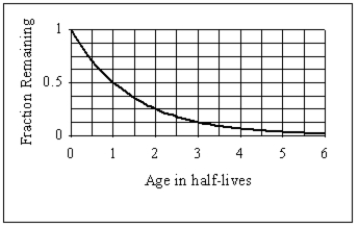
A)6.5 billion years
B)19.5 billion years
C)2.6 billion years
D)3.9 billion years
E)4.6 billion years

A)6.5 billion years
B)19.5 billion years
C)2.6 billion years
D)3.9 billion years
E)4.6 billion years

فتح الحزمة
افتح القفل للوصول البطاقات البالغ عددها 108 في هذه المجموعة.
فتح الحزمة
k this deck
36
Protoplanets of the Jovian planets could have grown very hot from
A)heat from the Sun.
B)radioactivity of light elements such as hydrogen and helium.
C)the infall of material at high velocity.
D)tidal forces due to the Sun.
E)collisions with large planetesimals.
A)heat from the Sun.
B)radioactivity of light elements such as hydrogen and helium.
C)the infall of material at high velocity.
D)tidal forces due to the Sun.
E)collisions with large planetesimals.

فتح الحزمة
افتح القفل للوصول البطاقات البالغ عددها 108 في هذه المجموعة.
فتح الحزمة
k this deck
37
Suppose that Mercury grew to its present size in 1 million years through the accretion of particles averaging 100 g each. On average how many particles did Mercury capture each second Note: Mercury has a mass of 3.3 × 1023 kg and a radius of 2439 km.
A)about 24 particles per second
B)about 3.3 × 1021 particles per second
C)about 67 particles per second
D)about 100 million particles per second
E)about 100 billion particles per second
A)about 24 particles per second
B)about 3.3 × 1021 particles per second
C)about 67 particles per second
D)about 100 million particles per second
E)about 100 billion particles per second

فتح الحزمة
افتح القفل للوصول البطاقات البالغ عددها 108 في هذه المجموعة.
فتح الحزمة
k this deck
38
The large planetesimals would have grown faster than the smaller planetesimals because
A)they were moving faster in their orbits than the smaller planetesimals.
B)their stronger gravity would pull in more material.
C)there was more material located near them that could be accreted.
D)the smaller planetesimals were covered by a layer of material that was lost during collisions.
E)All of the other choices are correct.
A)they were moving faster in their orbits than the smaller planetesimals.
B)their stronger gravity would pull in more material.
C)there was more material located near them that could be accreted.
D)the smaller planetesimals were covered by a layer of material that was lost during collisions.
E)All of the other choices are correct.

فتح الحزمة
افتح القفل للوصول البطاقات البالغ عددها 108 في هذه المجموعة.
فتح الحزمة
k this deck
39
The uncompressed density of a planet in our solar system
A)is greatest for the Jovian planets.
B)is greatest for the planets closest to the Sun.
C)is greatest for the planets furthest from the Sun.
D)is greatest for the planets with the largest mass.
E)is greatest of the planet with the largest radius.
A)is greatest for the Jovian planets.
B)is greatest for the planets closest to the Sun.
C)is greatest for the planets furthest from the Sun.
D)is greatest for the planets with the largest mass.
E)is greatest of the planet with the largest radius.

فتح الحزمة
افتح القفل للوصول البطاقات البالغ عددها 108 في هذه المجموعة.
فتح الحزمة
k this deck
40
The most important effect in clearing the solar nebula of gas and dust was
A)impacts by planetesimals.
B)the solar wind.
C)the Sun's magnetic field.
D)the asteroid belt.
E)radiation pressure.
A)impacts by planetesimals.
B)the solar wind.
C)the Sun's magnetic field.
D)the asteroid belt.
E)radiation pressure.

فتح الحزمة
افتح القفل للوصول البطاقات البالغ عددها 108 في هذه المجموعة.
فتح الحزمة
k this deck
41
in the following cartoon, the interior of a planet has separated into the layers shown by a process known as ___________. 
A)outgassing
B)differentiation
C)accretion
D)condensation

A)outgassing
B)differentiation
C)accretion
D)condensation

فتح الحزمة
افتح القفل للوصول البطاقات البالغ عددها 108 في هذه المجموعة.
فتح الحزمة
k this deck
42
Massive planets create ____________ Doppler shifts of their stars than lower-mass planets.

فتح الحزمة
افتح القفل للوصول البطاقات البالغ عددها 108 في هذه المجموعة.
فتح الحزمة
k this deck
43
After 3 half-lives, what percent of the original radioactive atoms are still in the sample as shown in the graph above 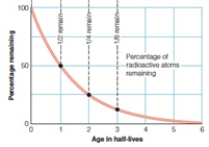
A)12.5
B)25
C)50
D)100

A)12.5
B)25
C)50
D)100

فتح الحزمة
افتح القفل للوصول البطاقات البالغ عددها 108 في هذه المجموعة.
فتح الحزمة
k this deck
44
From 20-25 days, the planet is 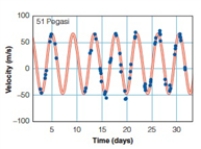
A)moving towards, then away from, then towards, then away from you
B)moving away from, then towards, then away from, then towards you
C)moving towards, then away from, then towards you
D)moving away from, then towards, then away from you

A)moving towards, then away from, then towards, then away from you
B)moving away from, then towards, then away from, then towards you
C)moving towards, then away from, then towards you
D)moving away from, then towards, then away from you

فتح الحزمة
افتح القفل للوصول البطاقات البالغ عددها 108 في هذه المجموعة.
فتح الحزمة
k this deck
45
The ___________ hypothesis of the formation of the solar system uses sudden events that drastically alter the form of the early solar system.

فتح الحزمة
افتح القفل للوصول البطاقات البالغ عددها 108 في هذه المجموعة.
فتح الحزمة
k this deck
46
The diagram below shows the radioactive decay of cesium (135Cs). What is the half-life of 135Cs
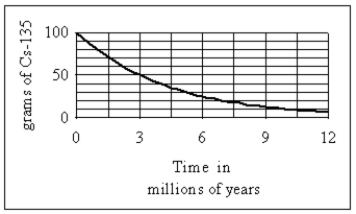


فتح الحزمة
افتح القفل للوصول البطاقات البالغ عددها 108 في هذه المجموعة.
فتح الحزمة
k this deck
47
Using the graph shown above, find out how many half-lives does it take for all radioactive atoms to decay into daughter products, 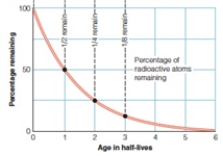
A)3
B)2
C)6
D)4

A)3
B)2
C)6
D)4

فتح الحزمة
افتح القفل للوصول البطاقات البالغ عددها 108 في هذه المجموعة.
فتح الحزمة
k this deck
48
Using the graph shown above, find out how many half-lives does it take for 3/4 of the daughter products to form. 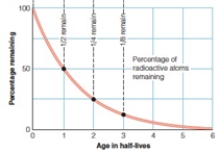
A)1
B)2
C)3
D)4

A)1
B)2
C)3
D)4

فتح الحزمة
افتح القفل للوصول البطاقات البالغ عددها 108 في هذه المجموعة.
فتح الحزمة
k this deck
49
How is the presence of space debris accounted for by solar system models
A)Space debris is left over material from the early solar system that never formed into a planet.
B)Space debris was formed by the collision of objects after the planets formed.
C)Space debris is material that existed in our region of space before the Sun formed.
D)Space debris is left over material from the early solar system that never formed into a planet and was formed by the collision of objects after the planets formed.
E)All of the other choices are correct.
A)Space debris is left over material from the early solar system that never formed into a planet.
B)Space debris was formed by the collision of objects after the planets formed.
C)Space debris is material that existed in our region of space before the Sun formed.
D)Space debris is left over material from the early solar system that never formed into a planet and was formed by the collision of objects after the planets formed.
E)All of the other choices are correct.

فتح الحزمة
افتح القفل للوصول البطاقات البالغ عددها 108 في هذه المجموعة.
فتح الحزمة
k this deck
50
The ____________ of a radioactive substance is the amount of time for the substance to be reduced by half.

فتح الحزمة
افتح القفل للوصول البطاقات البالغ عددها 108 في هذه المجموعة.
فتح الحزمة
k this deck
51
The adding of material an atom at a time to create a solid grain or flake is the process of ____________.

فتح الحزمة
افتح القفل للوصول البطاقات البالغ عددها 108 في هذه المجموعة.
فتح الحزمة
k this deck
52
The ____________ planets have larger radii than the ____________ planets.

فتح الحزمة
افتح القفل للوصول البطاقات البالغ عددها 108 في هذه المجموعة.
فتح الحزمة
k this deck
53
A planet found orbiting a star other than the Sun is called a(n) ____________.

فتح الحزمة
افتح القفل للوصول البطاقات البالغ عددها 108 في هذه المجموعة.
فتح الحزمة
k this deck
54
Which planetary fact(s) is(are) explained by the solar nebula theory
A)The orbits are all approximately in the same plane
B)The orbits are all in the same direction
C)Jovian planets are mostly H and He
D)Terrestrial planets are mostly rock and iron
E)All of the other choices are correct.
A)The orbits are all approximately in the same plane
B)The orbits are all in the same direction
C)Jovian planets are mostly H and He
D)Terrestrial planets are mostly rock and iron
E)All of the other choices are correct.

فتح الحزمة
افتح القفل للوصول البطاقات البالغ عددها 108 في هذه المجموعة.
فتح الحزمة
k this deck
55
The asteroid belt is found between which two planets' orbits
A)Earth and Mars
B)Mars and Jupiter
C)Jupiter and Saturn
D)Venus and Earth
A)Earth and Mars
B)Mars and Jupiter
C)Jupiter and Saturn
D)Venus and Earth

فتح الحزمة
افتح القفل للوصول البطاقات البالغ عددها 108 في هذه المجموعة.
فتح الحزمة
k this deck
56
________________ hypotheses involve a rare event in the origin of the solar system.

فتح الحزمة
افتح القفل للوصول البطاقات البالغ عددها 108 في هذه المجموعة.
فتح الحزمة
k this deck
57
How is radioactive dating used to determine the age of an object
A)Both the amounts of radioactive and decay material are measured. Using these with the radioactive material's half-life, the age can be estimated.
B)The amount of radioactive material is measured. Using this with the radioactive material's half-life, the age can be estimated.
C)The amount of decay material is measured. Using this with the radioactive material's half-life, the age can be estimated.
D)The amount of heat generated by radioactive dating is measured to determine age.
A)Both the amounts of radioactive and decay material are measured. Using these with the radioactive material's half-life, the age can be estimated.
B)The amount of radioactive material is measured. Using this with the radioactive material's half-life, the age can be estimated.
C)The amount of decay material is measured. Using this with the radioactive material's half-life, the age can be estimated.
D)The amount of heat generated by radioactive dating is measured to determine age.

فتح الحزمة
افتح القفل للوصول البطاقات البالغ عددها 108 في هذه المجموعة.
فتح الحزمة
k this deck
58
The object shown is a/an _____________ of less than 240 pounds. 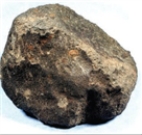
A)meteor
B)comet
C)meteorite
D)satellite

A)meteor
B)comet
C)meteorite
D)satellite

فتح الحزمة
افتح القفل للوصول البطاقات البالغ عددها 108 في هذه المجموعة.
فتح الحزمة
k this deck
59
The streak seen in the sky against the Milky Way background is a/an _______________. 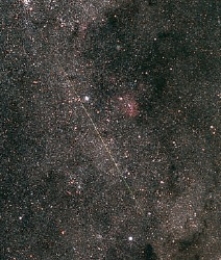
A)meteoroid
B)meteor
C)meteorite
D)All of the other choices are correct.

A)meteoroid
B)meteor
C)meteorite
D)All of the other choices are correct.

فتح الحزمة
افتح القفل للوصول البطاقات البالغ عددها 108 في هذه المجموعة.
فتح الحزمة
k this deck
60
in the following photo, where is the Sun located 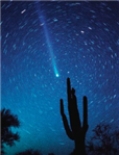
A)not shown but above the cactus
B)not shown but to the right of the cactus
C)not shown but below the cactus
D)not shown but to the left of the cactus

A)not shown but above the cactus
B)not shown but to the right of the cactus
C)not shown but below the cactus
D)not shown but to the left of the cactus

فتح الحزمة
افتح القفل للوصول البطاقات البالغ عددها 108 في هذه المجموعة.
فتح الحزمة
k this deck
61
Cold dust disks are _____________ disks around main-sequence stars, the dust of which is created by collisions among the planetesimals.

فتح الحزمة
افتح القفل للوصول البطاقات البالغ عددها 108 في هذه المجموعة.
فتح الحزمة
k this deck
62
A planet is much more massive than the star it orbits.

فتح الحزمة
افتح القفل للوصول البطاقات البالغ عددها 108 في هذه المجموعة.
فتح الحزمة
k this deck
63
The condensation sequence cannot explain the composition of the terrestrial and Jovian planets.

فتح الحزمة
افتح القفل للوصول البطاقات البالغ عددها 108 في هذه المجموعة.
فتح الحزمة
k this deck
64
The original cloud from which the Sun and planets formed had a composition rich in hydrogen and helium.

فتح الحزمة
افتح القفل للوصول البطاقات البالغ عددها 108 في هذه المجموعة.
فتح الحزمة
k this deck
65
The present motions of the planets were inherited from the rotation of the solar nebula.

فتح الحزمة
افتح القفل للوصول البطاقات البالغ عددها 108 في هذه المجموعة.
فتح الحزمة
k this deck
66
The Jovian planets have lower average densities than the terrestrial planets.

فتح الحزمة
افتح القفل للوصول البطاقات البالغ عددها 108 في هذه المجموعة.
فتح الحزمة
k this deck
67
Violent impacts of infalling particles release energy called ____________.

فتح الحزمة
افتح القفل للوصول البطاقات البالغ عددها 108 في هذه المجموعة.
فتح الحزمة
k this deck
68
We observe a planet crossing in front of its host star and the planet is smaller than the star. We call this crossing motion a ____________.

فتح الحزمة
افتح القفل للوصول البطاقات البالغ عددها 108 في هذه المجموعة.
فتح الحزمة
k this deck
69
Terrestrials are small, rocky, and dense.

فتح الحزمة
افتح القفل للوصول البطاقات البالغ عددها 108 في هذه المجموعة.
فتح الحزمة
k this deck
70
A planet is much brighter than the star it orbits.

فتح الحزمة
افتح القفل للوصول البطاقات البالغ عددها 108 في هذه المجموعة.
فتح الحزمة
k this deck
71
Outgassing refers to the formation of an atmosphere by the attraction of gases from the surrounding nebula.

فتح الحزمة
افتح القفل للوصول البطاقات البالغ عددها 108 في هذه المجموعة.
فتح الحزمة
k this deck
72
The pressure of sunlight was one of the forces that cleared the solar nebula.

فتح الحزمة
افتح القفل للوصول البطاقات البالغ عددها 108 في هذه المجموعة.
فتح الحزمة
k this deck
73
Observations in the infrared have detected a dusty disk around the star, Beta Pictoris.

فتح الحزمة
افتح القفل للوصول البطاقات البالغ عددها 108 في هذه المجموعة.
فتح الحزمة
k this deck
74
Jovian worlds that orbit close to their host stars are called ____________.

فتح الحزمة
افتح القفل للوصول البطاقات البالغ عددها 108 في هذه المجموعة.
فتح الحزمة
k this deck
75
Evolutionary hypotheses suggest that planets form by natural and gradual processes.

فتح الحزمة
افتح القفل للوصول البطاقات البالغ عددها 108 في هذه المجموعة.
فتح الحزمة
k this deck
76
The oldest objects found so far in our solar system are Earth rocks that are 1 billion years old.

فتح الحزمة
افتح القفل للوصول البطاقات البالغ عددها 108 في هذه المجموعة.
فتح الحزمة
k this deck
77
All old surfaces in the solar system were heavily cratered during the ________________ period by leftover debris from when the planets formed.

فتح الحزمة
افتح القفل للوصول البطاقات البالغ عددها 108 في هذه المجموعة.
فتح الحزمة
k this deck
78
When particles in the solar nebula grew large enough, they stopped growing by accretion and began growing by condensation.

فتح الحزمة
افتح القفل للوصول البطاقات البالغ عددها 108 في هذه المجموعة.
فتح الحزمة
k this deck
79
One common technique used to discover the presence of an extrasolar planet around a star is to detect how they tug their stars about, creating small Doppler shifts in the stars' spectra.

فتح الحزمة
افتح القفل للوصول البطاقات البالغ عددها 108 في هذه المجموعة.
فتح الحزمة
k this deck
80
____________ are icy bodies left over from the formation of the solar system and are an example of a planetesimal.

فتح الحزمة
افتح القفل للوصول البطاقات البالغ عددها 108 في هذه المجموعة.
فتح الحزمة
k this deck








